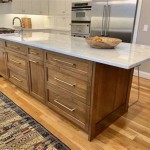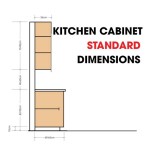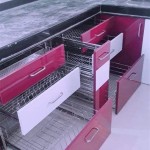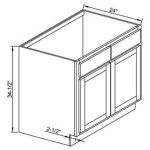```html
How To Clean Grease Buildup On Kitchen Cabinets
Kitchen cabinets, particularly those near the stove, are prone to accumulating grease buildup. This greasy film not only diminishes the aesthetic appeal of the kitchen but also attracts dust and other debris, leading to a sticky and challenging-to-clean surface. Regular cleaning is essential to maintain hygiene and prolong the lifespan of the cabinets. Different cleaning methods and solutions are available, and the choice often depends on the type of cabinet material and the severity of the grease buildup. This article provides a comprehensive guide on how to effectively clean grease buildup on kitchen cabinets.
Identifying Cabinet Material and Grease Level
Before commencing the cleaning process, it is crucial to determine the material of the kitchen cabinets. Cabinets are commonly made of wood (solid wood, plywood, or MDF), laminate, metal, or painted surfaces. Using the wrong cleaning solution can damage the finish or material. For instance, harsh chemicals can strip the paint off painted cabinets or damage the sealant on wooden cabinets. Consulting the cabinet manufacturer's guidelines or performing a spot test in an inconspicuous area is recommended to ensure compatibility.
The severity of the grease buildup also influences the cleaning approach. Light grease buildup can often be removed with gentle cleaning solutions, while heavier buildup may require more aggressive methods or specialized degreasers. Assessing the extent of the grease accumulation will help in selecting the appropriate cleaning agents and techniques.
Consider the age of the grease buildup. Fresh grease is generally easier to remove than old, hardened grease. Regular cleaning, even if it's just a quick wipe-down, is a preventative measure that significantly reduces the effort required for more thorough cleaning sessions later.
Gathering Necessary Supplies
Having the right tools and cleaning solutions on hand streamlines the cleaning process and ensures effective results. Essential supplies include:
- Microfiber cloths: These are ideal for wiping surfaces without scratching them.
- Soft-bristled brush: Useful for scrubbing stubborn grease buildup in textured areas.
- Spray bottle: For applying cleaning solutions evenly.
- Warm water: A fundamental component in many cleaning solutions.
- Dish soap: A mild degreaser suitable for light grease buildup.
- Baking soda: A natural abrasive that can help remove stubborn grease.
- White vinegar: An effective degreaser and disinfectant.
- Vegetable oil: Surprisingly effective for dissolving grease.
- Mild all-purpose cleaner: For general cleaning and maintenance.
- Rubber gloves: To protect hands from cleaning solutions.
- Protective eyewear (optional): To prevent splashes from entering the eyes.
- Scrubbing sponges (non-abrasive): For tougher stains, proceed with caution.
Preparing these supplies beforehand minimizes interruptions during the cleaning process. Organizing the tools and solutions also promotes efficiency and reduces the risk of spills or accidents.
Cleaning Methods for Different Grease Levels
Several methods can be employed to clean grease buildup on kitchen cabinets, depending on the severity of the problem. Each method utilizes different cleaning agents and techniques to effectively remove grease without damaging the cabinet finish.
Method 1: Dish Soap and Warm Water (For Light Grease)
This is the gentlest method and suitable for cabinets with light grease buildup. Mix a few drops of dish soap with warm water in a bowl or spray bottle. Dip a microfiber cloth into the solution, wring out the excess water, and wipe down the cabinets. Rinse the cloth frequently and repeat the process until the grease is removed. Finally, wipe the cabinets with a clean, damp cloth to remove any soap residue, and dry with another clean cloth.
The key to success with this method is to use a mild dish soap and avoid excessive soaking of the cabinet surface. Excess water can seep into the wood or laminate, potentially causing damage. Always wring out the cloth thoroughly before wiping.
Method 2: Baking Soda Paste (For Moderate Grease)
Baking soda is a mild abrasive that can effectively remove moderate grease buildup. Make a paste by mixing baking soda with a small amount of water until it forms a thick consistency. Apply the paste to the greasy areas and gently scrub with a soft-bristled brush or a non-abrasive sponge. Let the paste sit for a few minutes to allow the baking soda to loosen the grease. Wipe away the paste with a damp cloth and rinse thoroughly. Dry the cabinets with a clean cloth.
When using baking soda paste, avoid excessive scrubbing, especially on delicate cabinet finishes. Always test the paste in an inconspicuous area first to ensure it doesn't scratch or damage the surface. The abrasive nature of baking soda makes it ideal for textured cabinets where grease tends to accumulate in the crevices.
Method 3: Vinegar Solution (For Moderate to Heavy Grease)
White vinegar is a natural degreaser that can effectively cut through grease and grime. Mix equal parts white vinegar and warm water in a spray bottle. Spray the solution onto the greasy areas and let it sit for a few minutes. Wipe down the cabinets with a microfiber cloth. For stubborn grease, use a soft-bristled brush to scrub gently. Rinse the cabinets with a clean, damp cloth and dry with another clean cloth.
The acidic nature of vinegar can be beneficial for removing grease, but it's essential to dilute it properly. Undiluted vinegar can damage some cabinet finishes, especially those made of delicate materials. The vinegar smell will dissipate quickly, but it can be minimized by opening windows for ventilation.
Method 4: Vegetable Oil and Baking Soda (For Heavy Grease)
This method may seem counterintuitive, but vegetable oil can actually dissolve grease. Apply a thin layer of vegetable oil to the greasy areas of the cabinets. Let it sit for a few minutes to soften the hardened grease. Then, sprinkle baking soda over the oil and gently scrub with a non-abrasive sponge or microfiber cloth. The baking soda will act as a mild abrasive to remove the loosened grease and oil. Wipe away the mixture with a damp cloth and rinse thoroughly. Dry the cabinets with a clean cloth.
This method is particularly effective for removing hardened grease that has been accumulating for a long time. The vegetable oil breaks down the grease molecules, making them easier to remove. The baking soda helps to absorb the oil and grease, leaving the cabinets clean and residue-free.
Method 5: Commercial Degreaser (For Heavy Grease)
For extremely stubborn grease buildup, a commercial degreaser may be necessary. Choose a degreaser that is specifically designed for kitchen cabinets and follow the manufacturer's instructions carefully. Always test the degreaser in an inconspicuous area first to ensure it doesn't damage the finish.
When using a commercial degreaser, wear rubber gloves and protective eyewear to avoid skin and eye irritation. Ensure adequate ventilation by opening windows or using a fan. Apply the degreaser to the greasy areas and let it sit for the recommended time. Wipe away the degreaser with a clean, damp cloth and rinse thoroughly. Dry the cabinets with a clean cloth.
Tips for Preventing Grease Buildup
Preventing grease buildup is more effective than trying to remove it later. Implementing a few simple practices can significantly reduce the amount of grease that accumulates on kitchen cabinets.
Regularly wipe down the cabinets with a damp cloth and mild dish soap. This will remove any fresh grease splatters before they have a chance to harden. Use the exhaust fan or range hood while cooking. This will help to vent the grease and steam away from the cabinets. Cover pots and pans while cooking to prevent grease from splattering. Clean up spills immediately to prevent them from drying and hardening. Consider applying a protective coating to the cabinets, such as a sealant or wax. This will make it easier to wipe away grease and grime.
Consistent maintenance is crucial for keeping kitchen cabinets clean and grease-free. A few minutes of cleaning each week can prevent the need for more extensive and time-consuming cleaning sessions in the future. By following these tips and methods, homeowners can effectively clean grease buildup on their kitchen cabinets and maintain a clean and hygienic kitchen environment.
```
How To Clean Sticky Grease Off Kitchen Cabinets Ovenclean

How To Clean Kitchen Cabinets Everyday Skate

How To Remove Grease From Kitchen Cabinets 3 Methods Bob Vila

How Remove Grease From Wood Kitchen Cabinets

I M A Cleaning Whizz And My 80p Method Is Perfect For Getting Rid Of Grease Build Up On Your Kitchen Cabinets The Sun

Degrease Kitchen Cabinets With An All Natural Homemade Cleaner

How To Use A Hot Sponge Remove Grease From Kitchen Cabinets

How To Clean Grease Off The Most Common Kitchen Surfaces

How To Clean Old Grease From Kitchen Cabinets Fast Easy Sponge S

How To Remove Thick Grease From Kitchen Cabinets When Everything Else Fails








